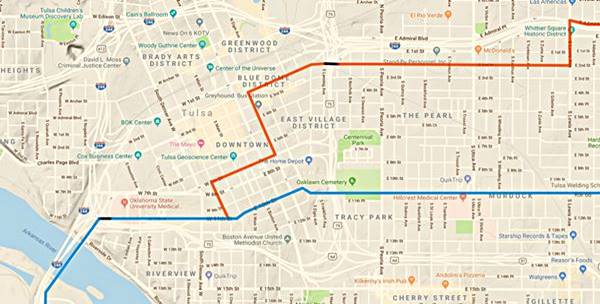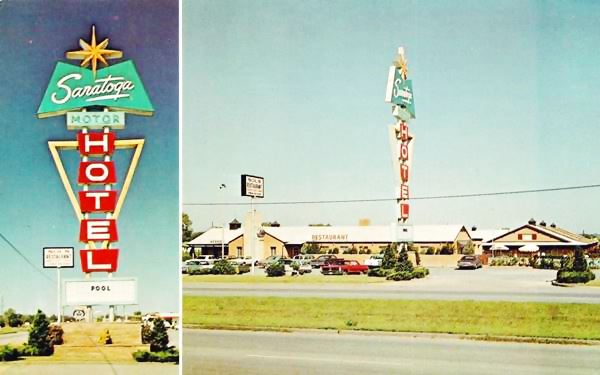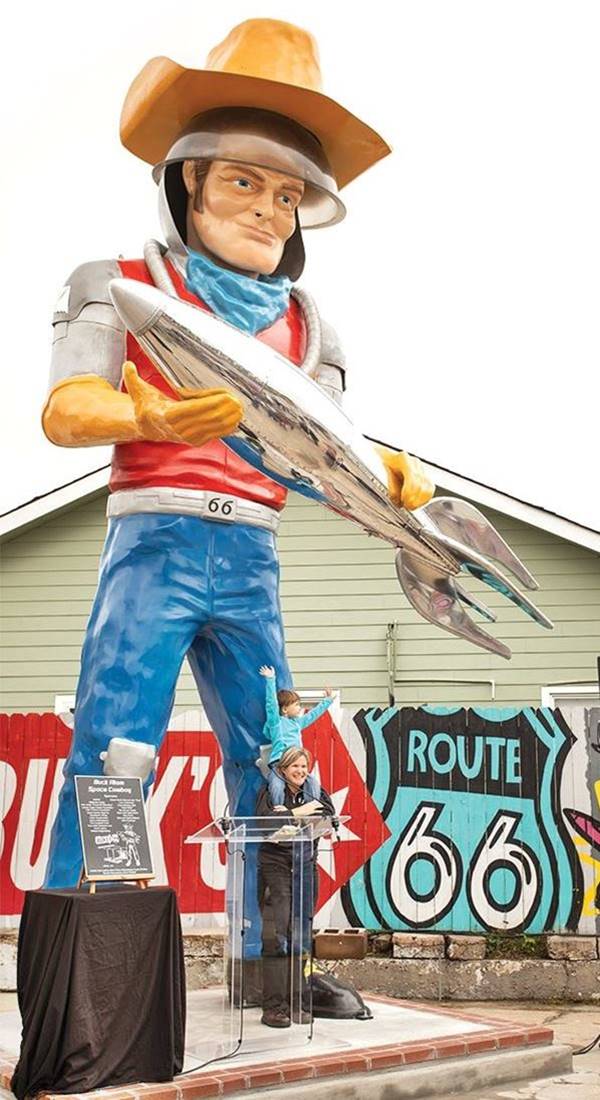
All About Tulsa, Oklahoma
Facts, Trivia and useful information
Elevation: 722 ft. (220 m). Population: 391,906 (2010).
Time zone: Central (CST): UTC minus 6 hours. Summer (DST) CDT (UTC-5).
Tulsa is the second-largest city in the State of Oklahoma and 47th-most populous city in the United States. It is the county seat of Tulsa county. The Metropolitan Area of Tulsa had over 960,000 residents and spans Osage, Rogers, Wagoner and Tulsa counties.
Its motto is: "A New Kind of Energy" and its nicknames are "Oil Capital of the World", "Tulsey Town" and "T-Town".
Tulsa skyline

Tulsa's History
This part of America has been inhabited for over 10,000 years. The Native American people were hunters and gatherers. The Spanish reached the region in the mid 1500s but didn't settle it; the French fur traders arrived in the late 1700s as they explored the Arkansas River upstream in what was then the French Louisiana.
After the US purchase of Louisiana in 1803, Oklahoma remained a remote area and was later designated as the "Indian Territory" and was to be used for the relocation of Native Americans, removed from their tribal lands in the East (this forcible relocation took place in the 1830s and is known as the "Trail of Tears").
The Osage people
The Osage had settled in what is now Osage county, Oklahoma by the mid 1700s. But they had to cede their claim to that land to the US government who in turn gave it to the Cherokee Nation that it was forcing to relocate in Oklahoma.
But the Osage returned to Oklahoma and repurchased 1.57 million acres (6.400 km2) of their former land from the Cherokee. It became a reservation on 1875; this land is just northwest of Tulsa.
The Creek people
The Creek tribe lived in Georgia and traded with the British colony established there. After American independence, the new state of Georgia forced them to cede their lands through a series of treaties between 1790 and 1805.
Discontent among the Creek led to the Red Stick War (1814) and even more land cessions (1825). Finally the Federal Government signed a treaty relocating them in the "Indian Territory" which would later become Oklahoma (1832). In 1836 they were forcibly expelled from Georgia and Alabama.
The Lochapoka Band of Creek Indians settled in 1828-36 in what is now Tulsa; their village was located close to present Cheyenne Ave. and 18th St., under an oak tree, the "Creek Council Oak Tree".
The Name Tulsa
It is the name that the Creek Indians gave to the village they established there in 1838; it was called "Tallasi" or "Tulasi" which means "old town" in Creek language.
The same word is the origin of the name of Tallahassee in Florida
A U.S. Army party explored the area in 1832, camping in what is now Washington Irving Park (after the famous writer who accompanied the party).
Lewis Perryman set up a trading post in the village in 1846, he was part Creek. The town grew with cattle trading and a post office was opened in 1879 and one of Lewis' sons was postmaster.
The Atlantic and Pacific Railroad which would later become the St. Louis and San Francisco Railway reached Tulsa in 1882.
Tulsa was incorporated in 1898; and the first oil well (Sue Bland N°1) was drilled in 1901, opening the oil-boom.
Population began to grow (from 1,390 to 141,258 residents between 1900 and 1930). By 1917, Tulsa called itself "The Oil Capital of the World" in 1917, and oil drove its economy.
Route 66 was aligned through the town in 1926, promoted by a local businessman, Cyrus Avery, known as "The Father of Route 66" who was part of the Committee that drew its alignment.
Racial Strife
The African American community in the Greenwood neighborhood was prosperous and peaceful, but the "Tulsa Race Riot" of May 31 and June 1, 1921 saw civil disorder and whites attacking blacks. The official toll was 39 dead (23 of them blacks), but the actual figure was closer to 300 dead (mostly black). 35 city blocks were burned and 10,000 people left homeless.
Oil wealth helped the town weather the Great Depression and the Dust Bowl, which hit the nation and Oklahoma hard.
After World War II, Route 66 became saturated, it was also unsafe so Oklahoma built the Turner and the Will Rogers Turnpikes linking Oklahoma City to Joplin, Missouri through Tulsa in 1957. The multi-lane highway bypassed the old segments of Route 66, but as they passed through Tulsa, they benefited its economy.
Where to Stay
There are plenty of hotels in Tulsa, you can take your pick.
> > Book your Hotel in Tulsa
Route 66 Accommodation close to Tulsa
Heading West....
- 67 mi. Chandler
- 104 mi. Edmond
- 115 mi. Oklahoma City
- 130 mi. Yukon
Find your hotel with this map
Booking.com>> There are several RV campgrounds in the Tulsa area.
Tulsa’s Weather
Where is Tulsa?

Tulsa has a temperate climate with rainfall concentrated during spring and summer, with occasional thunderstorms, hail and tornados.
The average high temperature in January is 48°F and the low is 27.5°F (8.9 and -2.5°C). In July the average high and low temperatures are 93.1 and 71.3°F (33.9 and 21.8°C). You can expect an average of 11 days per year with temperatures over 100°F (38°C).
Rainfall is 41 inches per year (1.041 mm) with most rain falling during May, June and Sept. There are 93 rainy days a year. Snow: 9.6 in. (24.3 cm) per year, between Nov. and March, the record: 29.6 inches in on e year.
Tornado risk
Tornado Risk: Tulsa lies within the "Tornado Alley in Oklahoma and experiences some 10 Tornado watches every year. Read more about: the risk of Tornadoes on Route66.
Getting to Tulsa
To the northeast are Catoosa (10 mi), and Claremore (28 mi). Sapulpa and Oklahoma City are west, along Route 66 and I-44.
Map of Route 66 through Tulsa
Static Map showing Route 66 alignment through Tulsa OK - CLICK ON MAP TO ENLARGE

Click on Map to Enlarge
Color Key to the Map of Route 66 in Tulsa (for the other parts of the map, check the color key of the map of the corresponding city)
Orange line is the 1926 to 1932 Route 66.
Pale Blue: US 66 alignment in Tulsa after 1932.
Black lines mark where the road is now cut and cannot be driven.
Map with directions: US 66 alignments through Tulsa
> > Eastern US 66 1926-32 in Tulsa (orange line in map above)
> > US 66 after 1932 in Tulsa (pale blue line in map above)
Route 66 Alignment into and through Tulsa
Visit our pages with old maps and plenty of information of the old US 66 roadway.
- Tulsa to Chandler (next)
- Vinita to Tulsa (previous)
Route 66 landmarks & attractions
Sights in Tulsa
Tulsa's Attractions
Tulsa has plenty of Route 66 attractions: historic vintage service stations, hotels and theaters, Art Deco buildings and a vibrant cultural life including museums and events.
Historic Context Route 66 in Tulsa: 1946
Jack DeVere Rittenhouse wrote about Tulsa in his classic "Guide Book to Highway 66", which he published in 1946 after driving Route 66 all the way from Chicago to Los Angeles. It gives us an idea of what it was like in Tulsa during US-66's heyday.
Rittenhouse tells us that 15 miles east of Tulsa US66 and OK-33 intersected, and there were cabins, garage and gas at that point. One mile ahead the road turned sharply west and two miles west, ran through Lynn Lane (a small community) with "several gas stations, a small garage and general homes. KVO court here".
In Tulsa Rittenhouse mentions "Several hotels including: Adams, Alvin, Bliss, Bradford, Cadillac, Corona, Tulsa, Mayo, Mercer, Oklahoma, Plaza, Seneca and Wells; courts include: Cook's, Park Plaza, Achor, Baker's, Blue Jay, Campbell's, El Reposo, Mid-Way, Rio, Shady-Rest, Tulsa, Whitt, Will Rogers, Grotto". On the west side of town he mentions Howard Park and the suburb of "Red Fork" he comments that the road into Sapulpa is "flanked with a constant succession of... tourist courts, garages, gas stations, etc."
Drive through Tulsa on Route 66
From the East
Coming from the east (from Catoosa), drive south along 193rd Street and then take a sharp right turn along E 11th Street. Ahead to your right is an old Gas Station
Stone faced Gas Station
17501 E 11th St., Tulsa
This old gas station has seen better days. Its gabled canopy stands over the now empty pump islands and the broken sign is rusting away.
Stone faced Gas Station in Tulsa, Oklahoma

You are in Lynn Lane and here is the KVO court mentioned by Rittenhouse in 1946 (to your right just west of S 157th Ave)
K.V.O. Modern Courts
15606 E 11th St. Tulsa, Tulsa
The postcard tells us that "E.F. Schmidt Proprietor, Reasonable Rates, 5 1⁄2 miles east of Tulsa".The stone buildings are as they appear in the postcard below. The trees of course have grown since the 1940s. But the roof shape and disposition of the double doors on the cabin is the same:
K.V.O. Modern Courts today in Tulsa, Oklahoma

K.V.O. Modern Courts detail from 1940s postcard

Head west, for 3 miles and after passing the freeway, to your right is a Classic Motel:
Brookshire Motel
11017 E 11th St, Tulsa
This motel now closed, has a classic neon sign and an appealing cottage styled office.
Brookshire Motel in Tulsa, Oklahoma

Continue west to the next "Motel":
Saratoga Motor Hotel
10117 E 11th St., Tulsa
The Saratoga "Motor Hotel" (what we now call a motel) had 85 rooms with a 24-hour Resturant, Circulating Ice Water, Continuous Hi-Fi Music and Radio, Large, Heated Pool and 1-Day Laundry Service. Credit Cards Honored and Free Airport Transportation.
Now it is the America's Value Inn and the original neon sign is still there though redesigned (yellow triangle and star gone) vertical "motel" letters with text in them, the "L" gone. And the upper green sign's shape has been modified.
Saratoga Motor Hotel vintage 1960s Postcard

Saratoga Motor Hotel nowadays:


Route 66 signage at Mingo Road, Tulsa, Oklahoma
Signs at Mingo Road and Interpretative Plaza
9701 E 11th St.
In the median strip of 11th Street at Mingo Rd. there was a sign marking the 1926-32 alignment (right along Mingo "Greenway"), the 1933-73 alignment (straight ahead on 11th St.) and to the left an arrow pointing towards the "Interpretative Plaza" (with parking space and some plaques and markers with information).
Side Trip to the 1926-32 Alignment
Take a 5.1 mile side trip (round trip) to visit Two Classic Sights on the first alignment of Route 66 in Tulsa. This is the Map with Directions.
Turn right along Mingo Rd. and head north. At the Admiralty Pl. roundabout is a very new sculpture completed in December 2018:
Route 66 Rising Sculpture
Cyrus Avery Traffic Circle

Route 66 Rising. KTUL
This is a gigantic sculpture, 70 feet wide and 30 feet high. it cost $655,000.
It was designed by Eric F. Garcia from Albuquerque.
This Roundabout known as Avery Traffic Circle, is the site of what was Cyrus Avery’s motel, inn and gas station. Avery is well known as the "Father of Route 66".
Turn west at the roundabout on Admiralty Pl. to visit Hank's Hamburgers:
Hank’s Hamburgers
8933 E Admiral Place Tulsa
Located on the north side of the road, it has been serving ham burgers, malsts and shakes since 1949. Even though in those days Route 66 had moved south to 11th St., it catered to locals and customers driving down US 75 or OK-33 into Tulsa.
Hank’s Hamburgers in Tulsa, Oklahoma

Turn right at Memorial Dr., cross the freeway and turn left at Easton St. to see a unique Drive-in theater:
Admiral Twin Drive-In
Route 66 Roadside Attraction
7355 E Easton St, Tulsa
It was built in 1951 and is one of the few drive-in theaters that have survived in Oklahoma.
With a capacity for more than 1,000 cars it is the largest drive-in theater in the state. It has a dual 9-story pair of screens. This is its Street view.
Now turn around and head back to 11th and Mingo, turn right and head west into Tulsa along the 1933-73 Route 66.
Again on 11th Street into Tulsa

Oasis Motel Neon Sign today, Tulsa, Oklahoma. Click to enlarge
Former Service Station
9347 E 11th St, Tulsa
To your right is a liquor store "Mad Dog Liquors" which used to be a Gas station, It still has a canopy over the concrete base that once had gas pumps. See its Street View.
Just ahead, also to your right is a Classic Motel and Neon Sign:
Oasis Motel
Classic Neon Sign
9303 E 11th St, Tulsa
The postcard below, postmarked in 1962, tells us that it had "Swimming pool - Room Phones - Room Coffee Service - Lounge".
It has a great neon sign which, rather suprisingly is very different to the original one as you can see in the "Now and Then" sequence below.
Usually the modern sign is uglier than the original one, in this case it is the opposite. There was a pool in the front lawn, which has now gone.
The sign is a googie style favored in the early 1960s, so it probably replaced the original one at that time. The "boomerang" on the sign is great!
Oasis Motel nowadays in Tulsa, Oklahoma

Oasis Motel old postcard in Tulsa, Oklahoma

Sheridan Hills Motel
6302 E 11th St, Tulsa
The current Super 11 Inn used to be the Sheridan. Its postcard tells us that it had all the comforts a traveler needed: "East edge of Tulsa York Air-Conditioning - Thermostat Heat control - Wall-to-wall Carpets - Tile Baths - TV's". Below is its "Now and Then" sequence:
Changed but still there; it lost its neon sign.
Sheridan Hills Motel 1950s postcard in Tulsa, Oklahoma

Sheridan Hills Motel current appearance in Tulsa, Oklahoma

Flamingo Motel
5915 E 11th Tulsa
The old Flamingo Motel is now the Western Inn. The postcard below tells us that it was "On U.S. 66, 10 minutes from downtown Tulsa, Oil Capital of the World. Phone TE 5-7647. A first class motel. Room phones, free television and radios, Refrigerated air conditioning - wall-to-wall carpeting, Tub Combination Tile bath, and lots of Hospitality. Visit the Gilcrease Indian Museum, Nationally famous. Heated swimming pool - new restaurant serving fine food, one block. AAA Approved".
It's classic neon sign is gone (it was blown down in a storm) and the pool has been filled in.
Flamingo Motel in a postcard

Flamingo Motel nowadays

A Great Classic Neon Sign
Continuing into Tulsa, to your left is a Great Neon Sign at a Classic Motel:
Desert Hills
5220 E 11th St, Tulsa
The hotel is still operating and has a fantastic neon sign. Its postcard pictured in the "Now and Then" sequence below announced: that it had "50 beautiful units... Free morning cofee served in Lobby - Fine Restaurants within walking distance"
Desert Hills in an old postcard

Viewed from the same angle today, the pool seen beyond the sign is gone and the canopy is now shorter.
Desert Hills nowadays in Tulsa, Oklahoma

Side Trip to a Gigantic Statue
Turn south on Yale Ave., see this Map with Directions for a short 3 mile round-trip to see a Example of Americana and Kitsch:

Golden Driller, 76 ft. tall. Greg McKinney
Golden Driller
An Oklahoma State Monument: Americana and Kitsch
21st St. and Pittsburgh Ave. Tulsa County Fairgrounds.
The first Golden Driller was built for the 1953 International Petroleum Exposition as a symbol for the "Oil Capital of the World". It was such a success that it was used again in 1959.
Its owner and sponsor, the Mid-Continent Supply donated it to the Tulsa County Fairgrounds Trust Authority and built the current and permanent version for the 1966 Expo.
It is 76 ft. (23 m) tall and designed to withstand winds of up to 200 mph. It contains 2.5 miles of steel rods and mesh and is covered in concrete. Its hand rests on a real oil derrick.
It is said to be the largest free-standing statue in the world and weighs 43,500 lb.
See a Street View of the Giant.
Retrace your steps and head west along Route 66 or add another round trip (16 miles - see this Map with Directions) to visit the "Praying Hands".

Praying Hands Sculpture, Joseph Novak
Praying Hands
7777 South Lewis , Tulsa
Tulsa is known as the "buckle of the Bible Belt" and is the site of Oral Roberts University and the university's Prayer Tower.
At the entrance to campus is the statue of the "praying hands", which is 60 feet (18 m) tall and the largest bronze sculpture in the world, it was cast in Mexico in 1980.
There is another Route 66 sculpture of praying hands in Webb City, Missouri.
Back to Eleventh Street and US66...
Once you finish the side trip, return to Yale and 11th Street, turn west (left) and continue your journey into Tulsa.
Great Classic Neon Sign
Neon Sign

Classic Neon Sign, Tulsa, Oklahoma. Click to enlarge
4507 E 11th St. Tulsa
Very probably a motel sign repurposed to serve as a used car dealership signIt has two slanted steel supports crossed by a red arrow and a yellow "boomerang" with two green bands linking them together. A 1950s design.
Sinclair Service Station
listed in the National Register of Historic Places
3501 East 11th St, Tulsa
Now restored and serving as the offices of Rossi Brothers, this station pictured below was built in 1929, it is a house with service bay station in Spanish Eclectic style typical of Sinclair, another example of "home-like" stations built to blend in with an urban setting. It is contemporary with the "Tudor Revival Cottage" styled gas stations favored by Phillips and Conoco (there are two of these "cottage" stations in Tulsa).
Just two blocks west, on the SE corner of Harvard is a Cottage style station pictured above:
Former Cottage Station
1107 Harvard Ave. Tulsa
To your left, on this former cottage style gas station now a store is located on a strategic corner, at Harvard and Route 66 (3300 block of 11th St.) The design was used by Phillips during the 1930s. It is pictured above.

Casa Loma now Campbell Hotel, Tulsa, Oklahoma. Click to enlarge
Campbell Hotel
Listed in the National Register of Historic Places
2636 East 11th St. Tulsa
Built in 1927 as the Casa Loma, later it became the "Campbell this classic recently revamped hotel is a half-block building along what was then Route 66.
The red-brick structure housed the "Casa Loma Hotel" on the second floor and commercial space at street level. It is an example of the Mission - Spanish Colonial Revival style.
For many years it was the "only hotel" east of town. Now it has been restored and is once again a hotel: Campbell Hotel.
> > You can Book a Room in the Campbell Hotel
Tulsa Monument Company Building
Listed in the National Register of Historic Places - Art Deco
1735 East 11th St, Tulsa
Built in 1936 the Tulsa Monument Company Building is a good example of Art Deco style architecture. It has a symmetrical facade, a rectilinear geometry with its triple banded pillar caps (known as the "3-Bar Modern" style) and the gray trim contrasting with the white plaster concrete. It was designed by Harry Mahler to look like a monument (hence its name).
Tulsa Monument Company Building in Tulsa, Oklahoma

Old Cities Service Gas Station
1502 E 11th St. Tulsa
Former Cities Service Gas Station from 1933 designed in Art Deco style by M. Pettinghill on a corner location (to your left), with a two bay garage and a glassed office. No canopy. It is pictured below (green building).
Across the street to your right is yet another former gas station (see its Street View):
Buck Atom: Space Cowboy - a Muffler Man
Kitsch on Route 66
1347 E 11th St. Tulsa
This old gas station has been refurbished and is now a shop selling Route 66 memorabilia: Buck Atom's Cosmic Curios.
The store owner, Mary Beth Babcock conceived Buck Atom, the Cosmic Cowboy when she operated a downtown boutique (2006 - 2016), and she made him something real: a modern day muffler man.
The brand new statue is 21 feet tall (6.4 m) and is the work of Joel Baker (he owns American Giants, a company that restores Muffler Men) and artists Mark Cline and Chris Wollard. They worked together to create the statue.

>> More information, visit: Muffler Men on Route 66
Just ahead, to your left by a Classic Neon Sign:
Meadow Gold Neon Sign
1300 block of 11th and Quaker Streets.
The Meadow Gold brand of milk and ice cream once belonged to Beatrice Food Company and was popular in the mid-western market in the years after World War II.
A sign with the brand name loomed over the intersection of Lewis Ave. and 11th. From the mid 1940s until 2004, when the building where it was mounted was sold and demolished.
The new owner of the lot gifted the sign and its supporting structure to the city. It was dismantled and structurally restored to retain its vintage look.
It was set up again to greet visitors entering the city as it did in the past a few blocks to the west.
Meadow Gold Neon Sign in Tulsa, Oklahoma

At the next corner, to your right is an Art Deco former gas station:
An Art Deco Gas Station
1303 E 11th St. Tulsa
Pictured further up, this former 3-bay garage gas station nowadays is "The Wrench Automotive Service", an auto repair shop. The classic lines of the rectangular building are clearly Art Deco: black tiles on the lower part of its facade, glass brick windows, a "3-Bar frieze" on the upper part of the facade.
Passing US-75 at the roundabout is another Art Deco building:
Warehouse Market Building

Art Deco Warehouse Market Building, Tulsa, Oklahoma. Click to enlarge
Art Deco
401 E 11th St, Tulsa
On the NE corner of South Elgin and 11th St., this one-story building (pictured below) with a terracotta tower was designed by B. G. Noftsger and constructed in 1929.
It served as the main grocery supply for Tulsa during the 1930s and was known as "The Farmer's Market". The decorations include two medalions beside its entrance, placed on large blue panels. The building's facade has been preserved.
This ends the tour of Eastern Tulsa
Tour Downtown and Western Tulsa
At this point you have two choices (you can do them both in the sequence you prefer) to keep on discovering and exploring Tulsa:
- Head west, leaving the downtown district and crossing the Arkansas River heading west into Western Tulsa
- Visit the sights in Dowtown Tulsa
Go to Downtown and Western Tulsa on the Next Page
The rest of Tulsa's attractions:
Some sponsored content
>> Book your Hotel in Tulsa


Comments & Responses
Sources
Jack DeVere Rittenhouse, (1946). A Guide Book to Highway 66.
Banner image: Hackberry General Store, Hackberry, Arizona by Perla Eichenblat.






See Comments & Responses